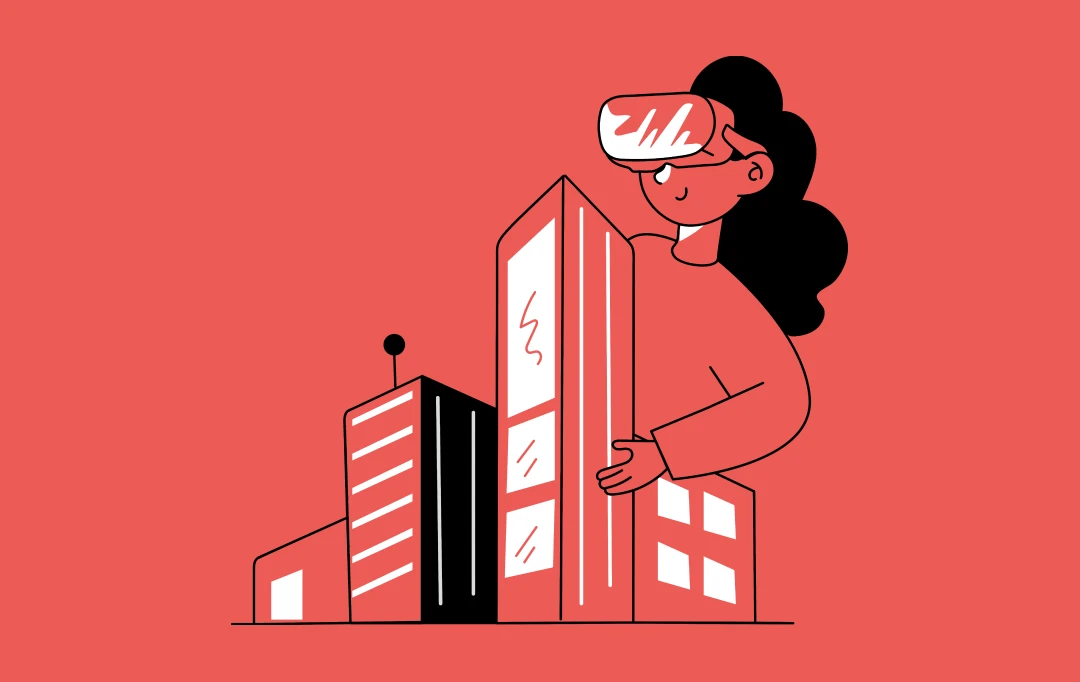- The Problem with Traditional Retail Marketing
- Insufficient Items
- Limited Personalization
- How Augmented Reality (AR) in Retail is Transforming the Shopping Experience for Users
- Personalization of User Content
- Ease of Trials/Tryouts
- Combining Traditional Retailing and Online shopping
- Connecting Shoppers with Printed Content
- Increasing Brand Presence and Awareness
- Dissipating Barriers to Language
- Earning Better ROI
- Improving the Shopping Experience
- Collecting Data on Customer Preferences
- Minimizes Returns Rate
- Reducing Hygiene Issues
- Brands that are Innovating with Augmented Reality in Retail
- Wayfair
- L’Oreal
- Nike
- Apple
- IKEA
- Vespa
- Topshop
- Sephora
- Adidas
- Final Note
- FAQs
Augmented Reality (AR) has advanced to a new level, aspiring to narrow the distance between online and offline stores. While the use of the technology in mobile apps was already reshaping retail businesses, the launch of web-based augmented reality (WebAR) has further inaugurated a paradigm shift in product interaction.
Evolving from viewing just a fraction of the product through static images on web pages, AR in retail now facilitates real-world product visualization, engaging customers on a personal level. It allows businesses to bring interactive product representation to consumers, delivering an immersive experience. 
This blog will uncover the transformative impact of AR in retail in detail. We will delve deep into the challenges, uncovering the limitations of traditional retail marketing, and understand why AR adoption is paramount.
The Problem with Traditional Retail Marketing
Earlier marketing forms needed a makeover with time as so many technological developments and the demand and supply for goods were increasing. Retail shops grew bigger, more people flogged in, and the system became more organized. Here are some points that highlight the overall challenges:
Insufficient Items
One recurring limitation of traditional retail business that you constantly face is items not in stock, and you don’t find that out unless you visit it. This issue persists regardless of external circumstances, making it a continual concern for businesses dealing with limited resources and potential stockpiling.
Limited Personalization
One of the biggest challenges businesses encounter in traditional retail marketing is to deliver personalized messages tailored to individual consumer behaviors and preferences. Traditional retail marketing methodologies fall short in providing the level of personalization that modern consumers expect, impacting the effectiveness of messaging.
Also Read: IoT in Retail – Use cases, challenges, process and costs
How Augmented Reality (AR) in Retail is Transforming the Shopping Experience for Users
Ever wondered what are the benefits of augmented reality shopping? Well the impact of Augmented Reality on retail has been monumental and it has added many benefits to the industry. From streamlining the processes to making shopping easier for people (both online and offline), AR in retail is a different ball game altogether. Below are the major benefits of augmented reality in retail shopping consumers have commonly observed.

Personalization of User Content
Retailers often customize content to meet the best expectations of the customer. You might’ve seen retail stores filtering out content for you so that you can look for relatable items without wasting time. Another technology called VR or Virtual Reality is also rendered for enhancement. Together, they provide comprehensive AR VR in retail solutions.
Ease of Trials/Tryouts
Waiting for your turn outside the trial rooms can be boring and time-consuming. Therefore, there are virtual mirrors where you can simply find the size of the dresses you like, and on a digital screen, you can see how that apparel looks and fits your body.
This exemplifies the remarkable impact of augmented reality in retail. You can do this in online shopping, too. While shopping for glasses, the app will scan your face to place the pair on your digital reflection. These types of gamification techniques play a huge role in driving retail sales.
Combining Traditional Retailing and Online shopping
Shopping is considered a fun activity. With so many retail stores and a huge population, shopping for the right things sometimes becomes jarring. One of the key benefits of AR in eCommerce is that it replicates the same ‘fun’ feeling of traditional shopping methods minus inventory costs and never-ending lines.
Connecting Shoppers with Printed Content
Printed products will not disappear in the future as they comprise a big chunk of marketing. It’s one of the masterstrokes of augmented reality marketing strategy. Have you ever observed how, just by holding your phone over a particular picture, you get all the related information and similar items of interest? Augmented reality in retail applications helps you do it. Many companies have adopted this. The New Yorker provides quirky animations on its magazines’ front and back covers.
Increasing Brand Presence and Awareness
AR is an amazing tool to enhance a company’s brand awareness to wider audiences. Mobile apps with state-of-the-art AR features will help a brand provide unique experiences to users. The use of AR for retailer marketing strategies gives a lot of leverage to brands to find ingenious ways for interactions, creating a tunnel for instant feedback.
Dissipating Barriers to Language
Although with so many languages worldwide, there are still certain barriers, but that’s just momentary. With Google Translate AR mode, you can see any of the 40 foreign languages as your native one. Features of AR-based shopping apps channel language(s) in such a manner that it is region-specific or, with the help of AR and AI tools, helps you understand its services. Even if you use printed catalogs, its AR content will guide you to choose the language of your convenience.
Earning Better ROI
AR is modern-day technology that changes frequently; therefore, an eCommerce or mCommerce retailer providing such facilities will earn much more than those not using it. Integration of AR in the retail sector has become a mandatory trend. Nowadays, making an AR app is easy and cost-effective.
Also Read: How Augmented Reality Benefits Businesses
Improving the Shopping Experience
To ensure customer loyalty and repeat visits, retailers should prioritize offering highly interactive shopping experiences, whether online or offline. Incorporating advanced in-store features like digital/virtual mirrors enhances the overall customer journey, fostering engagement and satisfaction. The continual improvement of these technologies contributes to a competitive edge, attracting and retaining customers in the long run.
Collecting Data on Customer Preferences
AR in retail facilitates the collection of data on customer preferences. This technology allows businesses to develop interactive and personalized experiences, gaining valuable insights into customers’ purchasing patterns, behaviors, and preferences. Retailers can make efficient, informed decisions by evaluating the data generated through AR interactions.
Minimizes Returns Rate
The boost of eCommerce also brings a headache of refunding and returning products for online businesses. Invesp states that the return rate of online-ordered products is 30%, whereas in brick-and-mortar stores, the return rate is 8.89%.
Analyzing the reasons for returning the products is crucial to reducing the returns rate. Some causes may include size, fit, unmatched product description, or a gift return. Looking at returns as an opportunity to build customer loyalty is the best way for businesses to curb product refunds and returns. Creating sizing charts, feature reviews, offering exchange during returns, and discovering the reasons behind returns are wise solutions to transform the error into an opportunity.
Integrating AR with e-commerce businesses will allow customers to virtually try-on products to alleviate issues like size and fit. Besides logistics cost reduction, AR will redefine the return challenges into an opportunity to build customer relationships.
Reducing Hygiene Issues
Considering the evolving landscape and the concerns around direct interaction with products have contributed to an upsurge in online sales. AR shopping experiences offering a virtual alternative to in-store visits closely mimic real-life shopping. Brick-and-mortar stores have incorporated AR marketing strategies, including the “Try On” and “Try Out” features, minimizing the need to handle products directly. AR integration in the retail industry caters to the evolving preferences for reduced physical interaction.
[Also Read: AR/VR Trends and Predictions For The Upcoming Years]
Brands that are Innovating with Augmented Reality in Retail
Prominent industry leaders have orchestrated noteworthy strides in business transformation through AR. Augmented reality benefits for online and offline shopping have convincingly been devised by brands to suit users’ preferences. Below, a few companies have etched their names in AR-based applications, providing customer-centric solutions.

Wayfair
Wayfair, a leading home-decor shopping application, has harnessed augmented-reality technology to enhance the customer experience. Shoppers on Wayfair can envision and visualize how the products seamlessly integrate into their living spaces. By capturing pictures of their room, users can imagine different products in their homes that are not actually present in their homes.
Know how much it costs to develop an app like Wayfair.
L’Oreal
L’Oreal with Facebook has launched an AR-enabled makeup try-on experience, revolutionizing AR in retail use cases. Customers can now virtually assess different makeup styles on their faces and experiment with renowned beauty brands like Maybelline, Giorgio Armani, Yves Saint Laurent, L’Oréal Paris, Urban Decay, and Lancôme, setting up a benchmark for personalized beauty exploration.
Nike
Nike incorporates technologies like AR and VR in retail. Customers can scan items like shoes or clothing to assess detailed product information. Moreover, Nike grants an immersive VR experience to its customers by allowing them to explore the different stages of Nike’s supply chain to communicate each product’s manufacturing process and origin transparently.
Apple
Apple strategically brought their in-store experiences home by leveraging AR technology to exhibit their products. The AR Quick Look allows customers to explore the latest Apple products like iPhone or iMac models by virtually placing them in their own space or hands for a personalized experience. This initiative underlines Apple’s commitment to delivering innovative shopping experiences.
IKEA
When shopping for furniture and electricals, IKEA is probably the most synonymous name to reckon with. Its artificial intelligence (AI), Machine Learning (ML), and AR technology in retail are really helpful for users. AR in IKEA apps allows users to take their phones, scan a particular piece of furniture, and then superimpose that into their room’s image. You can do it for your bedroom, kitchen, lavatory, hall, foyer, lawn, etc. This helps you save a lot of time and energy.

Vespa
After downloading the app, you just need to hover your phone over the magazine, and a scooter will automatically pop up. You can customize the vehicle as per your choice. You can change the colors, add/remove accessories, look for different styles, etc. Isn’t this a quirky use of AR marketing?
Topshop
The clothing giant Topshop is a spitting example of creativity with AR. In its retail stores, the company has set up kiosks where shoppers can see a digital reflection of themselves and try out each piece of clothing through the reflective image. Via hand gestures, the dresses can be changed one after the other. The whole process uplifts an individual shopper’s mood and the people nearby.
Sephora
Sephora has created an augmented reality experience, Virtual Artist App, using Modiface technology to help app users see how makeup products will look on their faces via their phone’s camera. Users can also find out which tools or products to apply to certain products. This technology boosts sales and encourages consumers to become brand ambassadors by recording and sharing their augmented reality experiences online.
Adidas
Since technology is all about innovation, Adidas testifies the statement with its use case of AR in eCommerce. A while ago, it changed the game by launching a new pair of sneakers. At ComplexCon CA 2018, the new AR feature made its debut. Users had to download the ComplexCon app on their smartphones, guiding them toward a destination to buy themselves new kicks. There were AR-powered signs in certain locations, and the users needed to just point their phones toward it and follow the instructions. This helped them buy shoes even without contacting any Adidas Originals employees.
Final Note
In this blog post, we explored how AR in retail is being leveraged and assists businesses in elevating their overall business strategy.
Appinventiv, as a reputed AR VR development company, has helped many startups, SMEs, and prominent brands with holistic augmented reality solutions. Our top-notch AR VR app development services have allowed businesses to gain a competitive edge that meets all their expectations.
Connect with us to create a sustainable long-term strategy and consider how AR technology in retail can enhance your customer’s shopping experience.
FAQs
Q. What is augmented reality in retail and its impact on sales?
A. AR in retail refers to using augmented reality, allowing customers to interact with products virtually through digital overlays. The impact of augmented reality is tremendous as it enhances customer engagement and saves time and costs, ultimately driving higher sales.
Q. How is AR transforming retail?
A. AR is transforming the retail landscape in various ways, such as creating immersive in-store experiences, interactive product visualization, customized shopping experiences, enhanced product education, etc., ultimately enabling brands to build a strong connection with their target audience.
Q. What is augmented retail strategy?
A. Augmented retail strategy illustrates integrating the technology to heighten the shopping experience, delivering personalized product interaction and driving engagement and sales.
Q. What is the cost of integrating AR in retail apps?
A. The cost of integrating AR into retail depends on the scale at which a retailer wants the brand presence to be felt. How you plan to give in a personal element depends on your intellect, innovation, and understanding of the market. Developing an AR in retail app can vary from $50,000 to $200,000. Connect with our retail software developers to get the complete cost estimation.
Q. What are AR trends in the retail industry?
A. AR trends in the retail industry include virtual try-ons for products, immersive AR shopping experiences, AR-powered product visualization, and interactive in-store displays. These innovative AR trends and augmented reality shopping experiences enhance customer engagement, reduce returns, and improve brand visibility in the market.



10 Use Cases and Examples of How Extended Reality (XR) is Driving Innovation Across Industries
Imagine a factory where engineers diagnose machinery issues using 3D holograms or a hospital where surgeons rehearse complex procedures in a fully immersive virtual space before operating on a real patient. These scenarios are not distant possibilities - they are happening today and are powered by Extended Reality - XR use cases. As a convergence…

13 Use Cases and Examples of How Adaptive AI is Transforming Industries
Slashing downtime, boosting margins, automating workflow, and stealing your market share. You must be thinking that these buzzwords are Silicon Valley’s hype. No, these are the silent revolutions hitting Main Street industries. From manufacturing deploying demand forecasting to controlling production lines, healthcare tailoring predictive care and driving better outcomes. The success mantra—these industries are quietly…

AR/VR in Construction - 10 Use Cases of How Augmented and Virtual Reality is Shaping the Industry
The use of extended reality technologies is one of the growing trends in the expanding domain of construction technology. As the sector gradually adopts more sophisticated practices, virtual and augmented reality in construction have emerged as revolutionary solutions. With compelling advantages like planning, marketing, and training, AR/VR technologies are transforming the face of construction. Prescient…

















